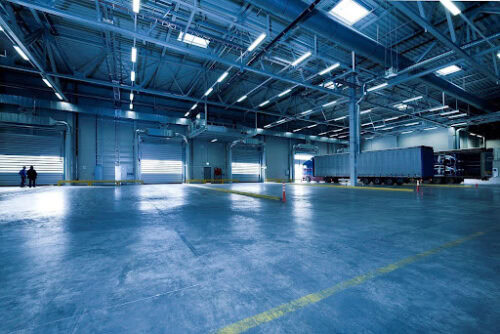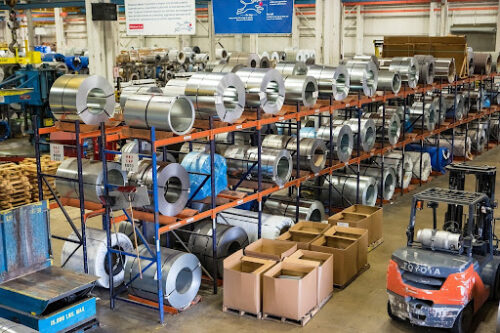Urban Warehousing: What It Is, Characteristics, and Benefits

Last-mile delivery has become a serious challenge for many businesses. Online shopping is growing fast, but getting products from warehouses to customers in urban areas is harder than ever. Roads are packed, customer expectations are high, and delays lead to lost sales.
As cities grow and e-commerce booms, the demand for effective urban warehousing solutions rises. This trend underscores the need for logistics strategies that address the limitations of metropolitan areas while optimizing delivery efficiency and sustainability.
Urban warehousing solves a big part of that problem. These are compact storage hubs placed within or close to densely populated urban areas to support faster last-mile delivery and improve overall logistics operations.
This guide will break down how urban warehousing solutions work, what makes them unique, how they help supply chains, and the obstacles companies need to think through before jumping in.
What are Urban Warehouses?
Urban warehouses are compact storage facilities placed inside or near densely populated areas to speed up deliveries. These sites serve as a critical component in modern logistics systems, helping businesses shorten the distance between products and end customers in busy city centers.
Unlike traditional warehouses located in distant industrial parks, urban warehouses support faster order cycles and reduced transportation distances. Their proximity allows companies to meet the demand for same-day delivery, especially in areas with high population density and active e-commerce markets.
Businesses rely on them to boost customer satisfaction and stay competitive in rapidly changing urban buying environments.
Urban Warehouse Characteristics
Urban warehouses stand out because they meet the rising pressure of modern logistics and efficient delivery in crowded cities. Here are the key characteristics:
- Maximize Space Utilization: Urban warehouses often rely on innovative solutions such as multi-story warehouses, vertical racks, and modular shelving to maximize limited storage space in city limits. By utilizing vertical space, they can store a diverse range of products efficiently without expanding the warehouse’s footprint.
- Technological Integration: Advanced tech like automated storage, robotics, and AI-driven warehouse management systems helps boost operational efficiency and reduce errors during the fulfillment process.
- Strategic Location: Sites near city centers, highways, or public transit reduce delivery times and cut down on transportation costs, improving speed and service for urban populations.
- Adaptability to Industry Needs: Urban warehouses are designed to support various sectors like e-commerce, retail, and food. They adjust layouts, temperature zones, and workflows based on different product demands.
The Benefits of Urban Warehouses
Urban warehouses offer game-changing advantages for companies facing the intense pace of city life and changing demand patterns. The following are the key benefits of urban warehousing:
Urban warehousing also plays a crucial role in promoting environmental sustainability. By reducing the distance goods need to travel, urban warehouses help lower carbon emissions and decrease the overall environmental impact of logistics operations. Adopting sustainable practices in urban logistics not only mitigates environmental impact but also supports broader goals of environmental sustainability.
Same-day Delivery

Placing inventory near urban centers allows faster response to orders. Businesses can offer same-day delivery without adding pressure on teams or networks. Speed creates a strong competitive advantage, especially in high-demand zones where meeting tight windows boosts customer satisfaction and strengthens loyalty through consistent, on-time fulfillment. Same-day delivery is crucial for meeting customer expectations, as it ensures that customers receive their orders quickly, enhancing their overall shopping experience.
Last-Mile Shipping Options
Urban warehouses reduce the distance between inventory and consumers. Electric vehicles help reduce transportation costs and environmental impact by providing quieter operations and lowering carbon footprints. Shorter routes cut transportation costs, open up flexible shipping models, and limit delays from traffic congestion. This structure helps businesses serve complex areas like New York and other metropolitan areas, where streamlined last-mile delivery directly affects speed and efficiency.
Catering to Urban Consumers
Growing demands for efficient solutions in urban logistics have led to the development of innovative urban warehouses. Modern urban consumers expect immediate, error-free service. Companies operating from densely populated cities can respond to orders quickly and minimize disruptions. This approach helps meet rising customer expectations, ensuring consistent, reliable service, which builds brand trust while adapting to fast-changing urban buying patterns and tight delivery timelines.
Quick Shipping
Speed plays a key role in urban logistics. Reducing delivery times and distances helps lower the carbon footprint, contributing to environmental sustainability. Companies with nearby inventory achieve faster city deliveries, gaining a clear edge in delivery performance. Urban warehousing helps reduce delays, improve consistency, and meet demand with fewer errors, even in zones with high operational costs and constant pressure on timing.
Hyperlocal Consumption
Urban warehouses support hyperlocal demand. Reducing transportation distances helps lower air pollution, contributing to a cleaner environment. Products stored nearby match buy-local trends while reducing transportation distances. This setup boosts efficiency, lowers environmental load, and answers the need for greener options. Consumers benefit from faster access to goods that are stocked closer to where they live, work, or shop.
Micro Fulfillment Centers
Small micro fulfillment centers process orders fast and close to customers. These centers improve logistics for the e-commerce sector by managing urgent requests with fewer delays. As part of broader urban networks, they support enhancing efficiency through scalable systems and faster turnaround, which helps businesses stay agile in crowded city zones.
Vertical Warehousing
Urban space remains limited, so vertical models make sense. Companies build up instead of out, increasing storage capacity without growing their physical footprint. In the densest urban areas, vertical warehouses are strategically placed in city centers, transitioning from large, remote warehouses to compact spaces. This multi-level storage keeps operations lean, supports scalability, and offers smart use of space in line with dense zoning and property constraints.
Solving the Last-mile Delivery Challenge
Urban warehousing addresses the most expensive and unpredictable step in the delivery process: reaching the customer’s doorstep. In dense cities, that final mile can account for over 50% of total logistics operations costs.
Logistics activities play a crucial role in enhancing operational efficiencies within urban logistics by integrating AI and big data to optimize delivery routes and predict demand, ultimately streamlining logistics processes.

Facilities in strategic locations eliminate unnecessary travel. Products stored within city boundaries cut down on delays, reduce transportation costs, and support efficient movement.
Urban warehouses also enable faster fulfillment models. Orders can reach customers the same day, or even within hours. This speed boosts customer satisfaction and helps businesses outperform slower competitors.
The Challenges of Urban Warehouses
Urban warehouses offer speed, but they also come with limits. Companies must deal with cost, space, and city-related hurdles before scaling urban warehousing in areas with high population density. One significant environmental challenge is noise pollution, which contributes to air pollution and traffic congestion. The following are the potential challenges to look for:
Limited Space
Crowded urban areas leave minimal room for expansion. Efficient inventory management, including tracking and predicting stock levels, is crucial in these limited spaces. Small plots limit storage capacity, slow down retrieval systems, and restrict layout flexibility. These limitations make it harder for e-commerce businesses to scale efficiently while handling fluctuating order volumes and rising pressure for quicker order fulfillment, making on-demand warehousing a highly beneficial solution.

Elevated Real Estate Cost
Strong demand and tight availability drive high real estate costs in urban logistics hubs. Elevated real estate costs lead to higher storage costs, adding to the financial burden on businesses. Leasing or buying space often requires a major upfront investment, increasing operational costs. These financial pressures can make urban warehouse models difficult to justify for small businesses with tight profit margins.
Traffic Congestion
Busy city streets cause constant traffic congestion, delaying delivery vehicles and complicating schedules. Urban logistics plays a crucial role in sustainable urban development by addressing these challenges through innovative solutions and strategic planning. Unpredictable routes lower delivery reliability and strain warehouse operations, making it harder to meet promised timelines or maintain consistency across peak hours and shifting city-wide traffic conditions.
Labor Shortages
Recruiting skilled warehouse staff in urban environments remains difficult due to high competition and job turnover. The logistics industry plays a crucial role in addressing urban development challenges, such as traffic congestion and environmental concerns, through innovative solutions and strategic planning. Limited labor pools force companies to offer higher wages, increasing costs, and making efficient management of daily operations more difficult to maintain at the required pace.
Environmental Concerns
High-frequency urban deliveries often raise emissions. The urban environment necessitates sustainable practices in urban logistics to address these challenges. Extra trips made by fuel-powered delivery vehicles impact air quality in city logistics zones. Pressure mounts for adopting sustainable practices, including electric fleets and clean energy infrastructure, to reduce the overall environmental impact of urban fulfillment.
Changing Consumer Expectations
Urban warehouses play a crucial role in meeting consumer expectations by providing flexible delivery windows, faster service, and seamless returns. Adapting to these shifting needs through static warehouses can be difficult. Urban logistics must innovate rapidly to align with rising expectations and unpredictable trends shaping buyer behavior in crowded cities.
Considerations Before Adopting Urban Warehousing
Urban warehousing offers major upside, but it demands careful thinking. Planning helps companies avoid setbacks and keep pace with growing expectations in urban logistics. Understand these potential considerations before adopting:
Strategically positioned urban warehouses are crucial logistical hubs that enhance delivery efficiency by being located closer to customers. This strategic location facilitates same-day delivery, addressing the increasing demand for speed and convenience in e-commerce.
- Cost-Benefit Analysis: Weigh high real estate costs against possible gains in delivery times and customer satisfaction to decide if the location justifies the expense and long-term commitment.
- Logistical Assessments: Ensure systems support real-time tracking, optimized routing, and fast inventory management. Efficient staff workflows and strong tech are needed for solid warehouse operations in tight spaces.
- Market Demand: Check if your market needs fast delivery. Not all customers demand speed, so test if urban consumers in your region value same-day shipping enough to support the investment.
- Regulatory Compliance: Review local zoning laws and pollution limits. Many urban areas regulate noise, emissions, and traffic flow, which can impact your daily operations or delivery timelines.
The Future of Urban Warehousing
Urban warehousing continues to evolve. As growing demand reshapes city logistics, businesses will need to adopt smarter tools, cleaner operations, and faster delivery networks.
- Technology Integration: Automation and robotics will speed up order processing, reduce manual tasks, and boost accuracy. These tools support higher productivity and smoother urban logistics in tight spaces where human labor and floor space are limited. A warehouse management system (WMS) will be crucial in future urban warehousing, streamlining operations by managing inventory, optimizing storage and picking processes, and ensuring efficient order dispatch.
- Sustainability Initiatives: Companies will adopt sustainable practices like EV fleets, solar-powered buildings, and smart energy systems. These steps help reduce emissions, lower the environmental impact, and align operations with eco-conscious regulations in urban environments.
- Expansion of Micro-Fulfillment Centers: Brands will increase investment in micro-fulfillment centers to serve local markets. These compact hubs reduce delivery times, support faster last-mile delivery, and improve flexibility across dynamic, high-volume e-commerce order environments.
Conclusion
Urban warehousing plays a critical role in solving last-mile delivery problems in the retail warehousing sector. By placing facilities closer to end-users, businesses can respond faster, reduce delays, and improve supply chain efficiency. Faster service, lower transit times, and proximity to buyers are just a few urban warehouse pros reshaping how companies operate in dense cities.
Despite the benefits, urban warehousing comes with hurdles. Increased operational costs, limited space, and zoning rules require strategic planning and smart execution.
Companies must stay flexible, track trends, and adopt innovative strategies that match the pace of growing demand and support sustainable practices in transforming urban logistics beyond the industrial park model.
